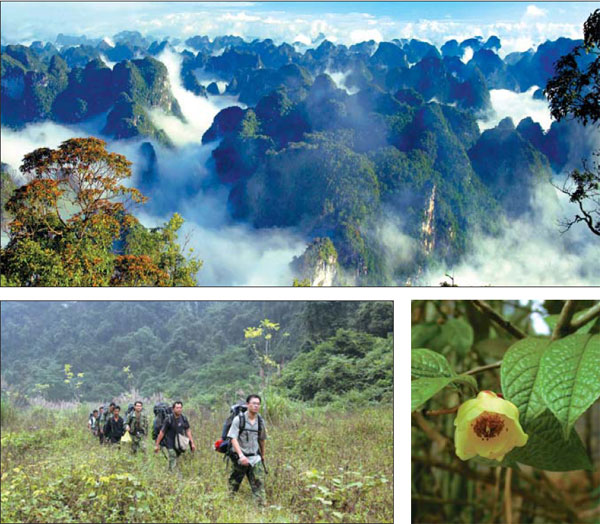
Clockwise from top: A panoramic view of the Nonggang reserve. A blossoming golden camellia flower. Rangers on the way for their patrol and monitoring work. Photos Provided to China Daily
"That's part of the reasons why Nonggang has never been short of scientific discoveries."
Besides the eight new plant species, he says, 11 species of plants found in the reserve are either Guangxi's or the country's new record species.
In November, 2011, Chen Tianbo, a protection station manager, caught a snake during a survey. Chen and his research partners later found out that the reptile was the same as the snake caught a little earlier in a Vietnamese reserve. It is a new species. In October 2012, researchers from both sides jointly published the finding.
"Nonggang's habitats are similar with some habitats in the reserves in Vietnam," Chen says. "In the scientific field, our competitors are often our neighbors."
What has really brought fame to the reserve is the discovery of Nonggang babbler.
The myna-sized brown bird, with a white crescent-shaped patch behind the ear and some grayish-brown spots on the white throat, is a new bird species discovered by Chinese ornithologists.
It is the second time Chinese scientists have found a new species of bird in the country. The first was in the 1930s.
"Since it was formally published in 2008, the Nonggang babbler has become the reserve's name card," Meng says. "More researchers came. We also began receiving birdwatchers from home and abroad."
Better protection
The director attributes the discoveries to the reserve's better protection.
About 80 rangers are working at six protection stations. Now they use GPS devices and cameras. Data from their daily patrols and monitoring are input into computer and used for the reserve's geographic information system, which is still under construction.
Although about 14,000 people live around the reserve's 63 villages, cases of poaching protected animals are scarce, Meng says.
